African Gods Are Also Cool! Know Your History!
As an anthropologist, I have come to learn that it is an unwise activity to compare cultures based on technological advancement or any other criteria really because every culture has it's own unique history and is subject to different determining influences (FRANZ BOAZ - historical particularism).
As a result of imperialism and colonial influence, Africans have been forced to abandon their gods because of western religion that portrays African traditional religion as bad and evil in its practice. When you worship a God that says "You shall worship no other God but me" , it becomes pretty hard to keep on worshipping your traditional gods if you want to go to your God's heaven. As a result, many African gods have faded into the ether, their glory weakened by the influence of modern religion.
Yet, it is this modern religion that unwittingly champions strife and divisions, clearly outlining differences between "them" and "us". This is unlike the African Traditional religion that is all accommodating. I mean, you can even find up to 7 gods in a family's shrine and they are all worshipped equally. But modern religion refuses to share worship or acknowledge the rightness or legitimacy of African traditional religion.
On another level, a lot of modern day Africans believe their traditional gods to be old men with broken teeth in wrappers, and others consider the stories of their feats and powers too colourful to be real, and prefer to be interested in the safety and comfort of Foreign gods like Thor, Loki, Zeus, Apollo and the rest of the Greek, Roman and British gods. The only African gods that have been able to feature in today's entertainment industry are the Egyptian gods in Gods of egypt and American gods.
But this post wants to shed light on some African gods and their amazing power. A lot of African gods, especially Yoruba gods, are actually popular and most are worshipped in tropics like Brazil and Cuba. Outlined below are some African gods and their amazing spheres of influence. Yes, African gods are hot too!
Osanyin
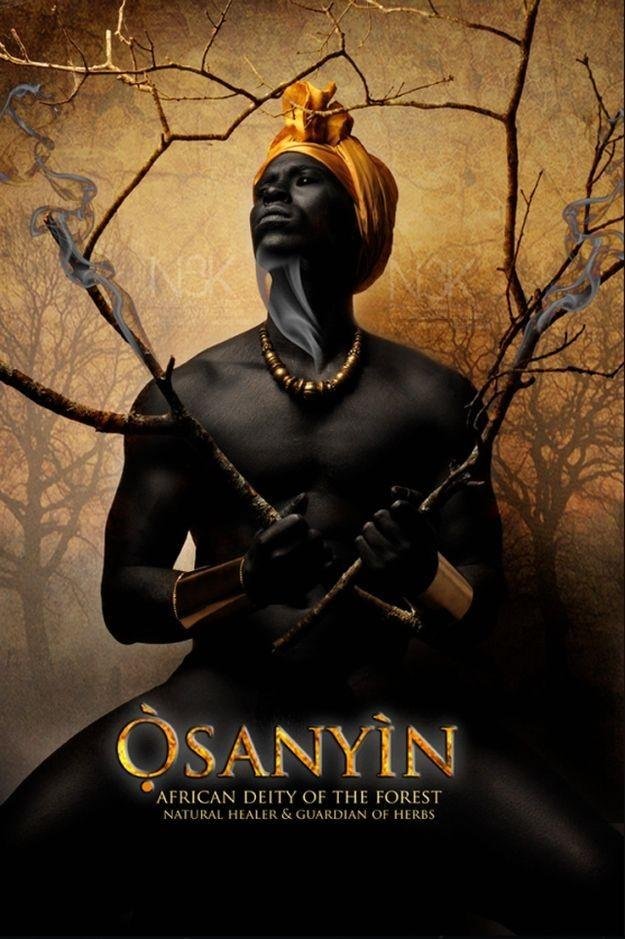
Osanyin (also called Osain) is the orisha of all plant-life, healing and magic. He is known as a powerful wizard and master of all spells and crafts found in the wild and the untamed areas of nature.
More Details...
Osanyin’s knowledge and dominion over plant-life is often told and retold in the sacred texts of the Ifa. Osanyin was a lame orisha, missing a leg and arm, and blind in one eye. But his older brother Orunmila wanted Osanyin to feel worthy, so he arranged to leave Osanyin on the farm early in the morning with the instruction to pull weeds from between the rows of crops. When Orunmila returned in the evening, he found his younger brother in the middle of the field crying, without having pulled a single weed. Upon asking why his brother why he was weeping and why he had not completed his task, Osanyin replied, “You have asked me to pull the weeds, but there is not one weed here.” He pointed to a plant, and said, “You would have me destroy this, but this will cure ailments of the heart.” He then proceeded to point out many other plants, identifying each of their spiritual qualities and medicinal uses. Orunmila was surprised that his brother had such deep knowledge!
Sango is one of the most popular African gods, renowned for his ability to breathe fire and command lightning. In addition to his famous temper of course.
He was a strong ruler and a notable magician. Sango was the third king of the Oyo Kingdom. He succeeded Ajaka, son of Oranmiyan who appears to have been a weak ruler. His symbol is a double-headed axe, which represents swift and balanced justice.
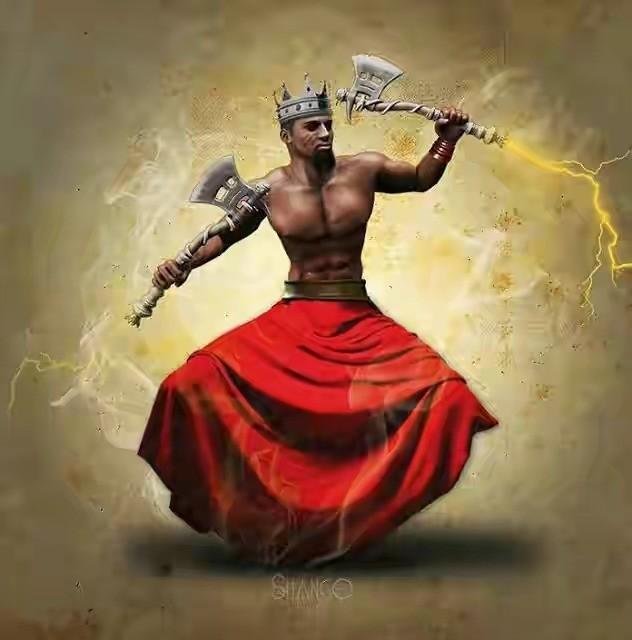
He is the owner of Bata ( double-headed drums), as well as the Arts of Music, Dance and Entertainment in the Yoruba Culture. In the Lukumí (Olokun mi which means “my dear one”) religion of the Caribbean, Sango is considered the center point of the religion as he represents the Oyo people of West Africa.
More details...
Sango displayed his magical powers by directing lightning unto his own household killing his wives and children. He got angry and entered the ground in Ira by himself after the incidence; he was deified as the god of thunder and lightning. Sango as purpoted did not hang himself. Sango’s followers went to another village to acquire magical powers and returned furiously to destroy the enemies of Sango in old Oyo.
Reference
Orunmila
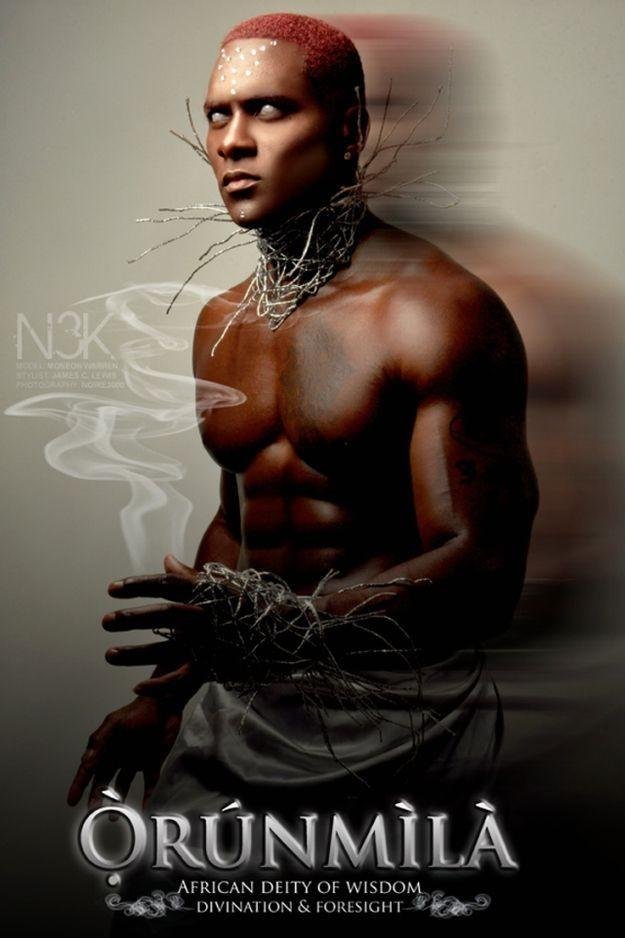
He is the Orisha of wisdom, knowledge, and divination. This source of knowledge is believed to have a keen understanding of the human form and of purity, praised as being often more effective than other remedies.
Orunmila is recognized as a primordial Irunmole that was present both at the beginning of Creation and then again amongst humanity as a priest that taught an advanced form of spiritual knowledge and ethics, during visits to earth in physical form or through his disciples. Orunmila is the spirit of wisdom among the Irunmole and the divinity of destiny and prophecy. He is "Ibikeji Olodumare" (second in command to Olodumare) and "eleri ipin" (witness of fate). It was also Orunmila who carried Ifá (the wisdom of Olodumare) to Earth. Priests of Ifá are known as babalawos and Priestesses of Ifá are known as Iyanifas.
Orunmila is considered a sage, recognizing that Olodumare placed Ori (intuitive knowledge) as prime Orisha. It is Ori who can intercede and affect the reality of a person much closer than any Orisha.
Source
Olokun
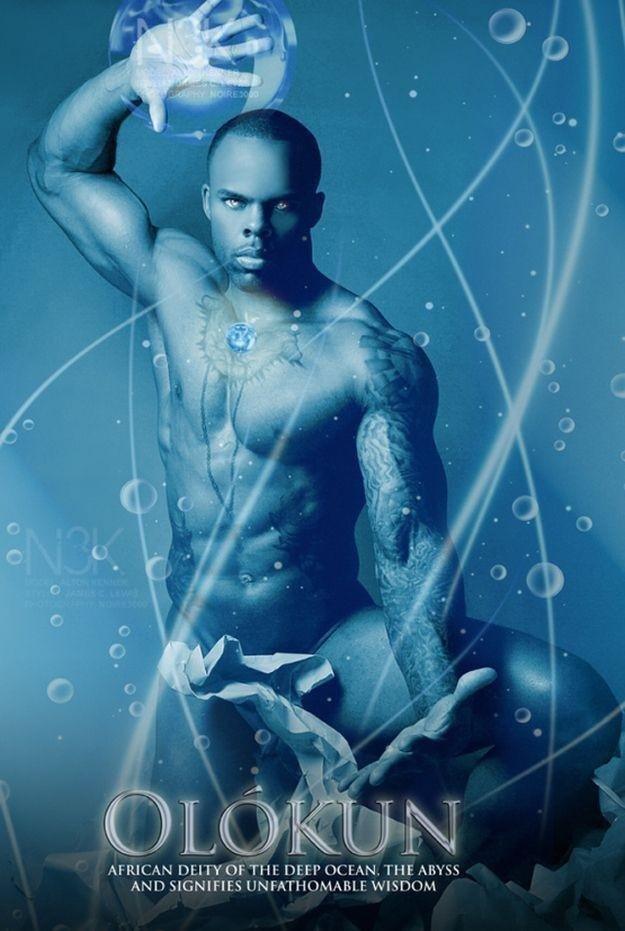
Olokunola is the only God that is both male and female. He is believed to be the parent of Aje, the orisha of great wealth and of the bottom of the ocean. Olokun is revered as the ruler of all bodies of water and for the authority over other water deities. Olokun is highly praised for her or his ability to give great wealth, health and prosperity to her or his followers. Communities in both West Africa and the African diaspora view Olokun variously as female, male, or androgynous.
Esu
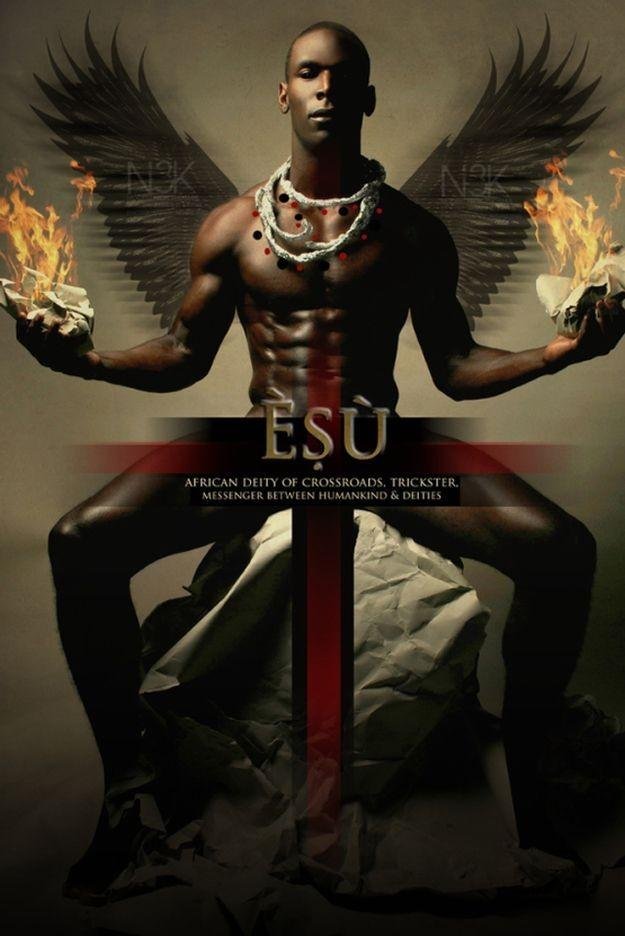
This Esu is different from the one portrayed by the Bible as Satan. Esu is a fundamental Orisa and of great importance in Yoruba land. There is no shrine you will get to in Yoruba land where you will not see the image or a representation of Esu. It is believed by the Yoruba that Esu has two hundred names.
More details...
Esu is primarily a special relations officer between Orun (heaven) and Aye (Earth). He is the “inspector – general” or the confidential secretary of Olodumare, which makes the final recommendation to Olodumare for the latter approval. He also reports on regular basis to Olodumare on the deeds of men and divinities, incorrectness of worship in general and sacrifices in particular.
Obatala
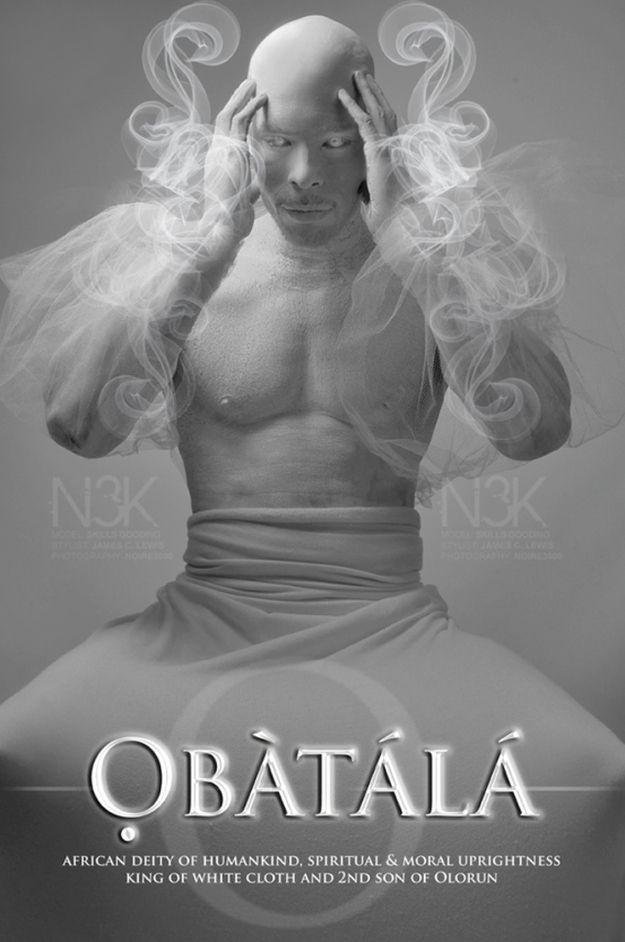
He is the Sky Father and the creator of human bodies, which were brought to life by Olodumare's smooth breath. Obatala is the father of all Orishas and the owner of all ori. Any Orisha may claim an individual, but until that individual is initiated into the priesthood Osun is of that Orisha, Obatala still owns that head. Obatala's principal wife is Yemoo
Oshun
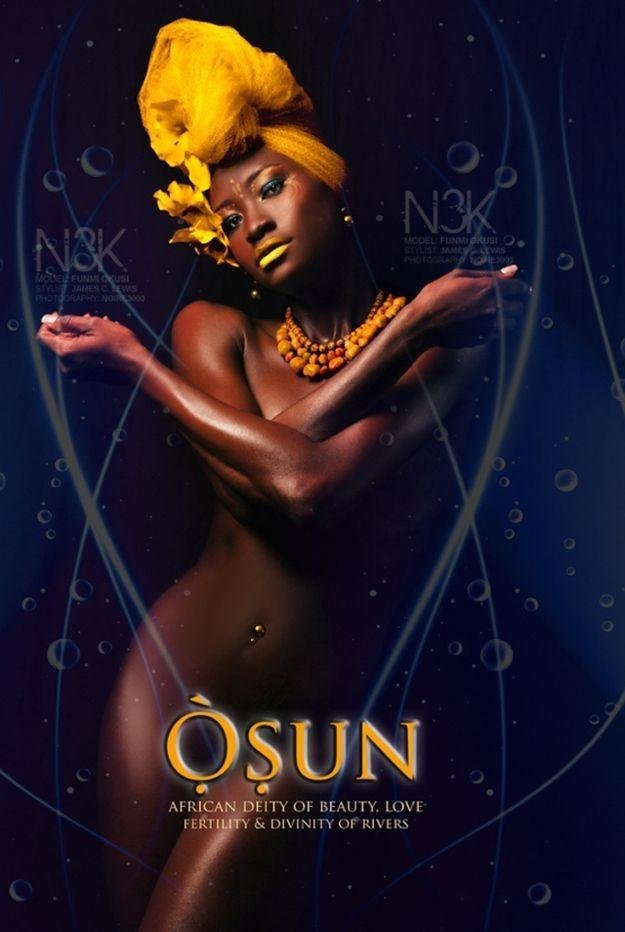
Osun is an orisha (deity) of the Yoruba people of southwestern Nigeria. Oshun is commonly called the river orisha, or goddess, in the Yoruba religion and is typically associated with water, purity, fertility, love, and sensuality. She is considered one of the most powerful of all orishas, and, like other gods, she possesses human attributes such as vanity, jealousy, and spite.
Several myths exist concerning Oshun and her significance as a Yoruba deity. In most Yoruba stories, Oshun is generally depicted as the protector, saviour, or nurturer of humanity. Oshun has also been described as the maintainer of spiritual balance or mother of sweet things. One myth highlights Oshun as the central figure in the creation of human beings. The Yoruba people believe that the orishas were sent by Olodumare, who is considered the Supreme God, to populate the Earth. Oshun, being one of the original 17 sent to Earth, was the only female deity. The other gods, all male, failed at their attempts to revive and populate the Earth. When they realized they were unable to complete the task given to them by Olodumare, they tried to persuade Oshun to help them. Oshun agreed and brought forth her sweet and powerful waters, bringing life back to Earth and humanity and other species into existence. As that Yoruba myth suggests, humanity would not exist if Oshun, the goddess of life and fertility, had not acted.
Other myths hold that Oshun is one of the wives of Shango, the god of thunder. She is commonly described as the favourite of all orishas by Olodumare, because of her beauty and sensuality. In yet another Yoruba story, Oshun is depicted as the goddess who not only gives life but also takes it. When angered, Oshun may flood Earth or destroy crops by withholding her waters, thereby causing massive droughts. In one myth, Oshun is incensed by her devotees and sends down rain, nearly flooding the world. Yet once she has been appeased, Oshun saves Earth from destruction by calling back the waters.
Tradition holds that the first interaction between Oshun and human beings took place in Osogbo (Oshogbo), Nigeria. That city is considered sacred, and it is believed to be fiercely protected by the water goddess. Oshun is said to have given the people who went to her river permission to build the city and promised to provide for them, protect them, and grant their prayers if they worshipped her dutifully, making the obligatory offerings, prayers, and other rituals. Out of that first encounter between the people of Osogbo and Oshun evolved the Oshun festival, which is still practiced today by the Yoruba people. Every year Oshun devotees and other people of the Yoruba religious tradition go to the Oshun River to pay homage, make sacrifice, and ask for a variety of things such as wealth, children, and better health. Although other orishas are honoured during the festival, the climax of the festival is centred on Oshun.
Oba
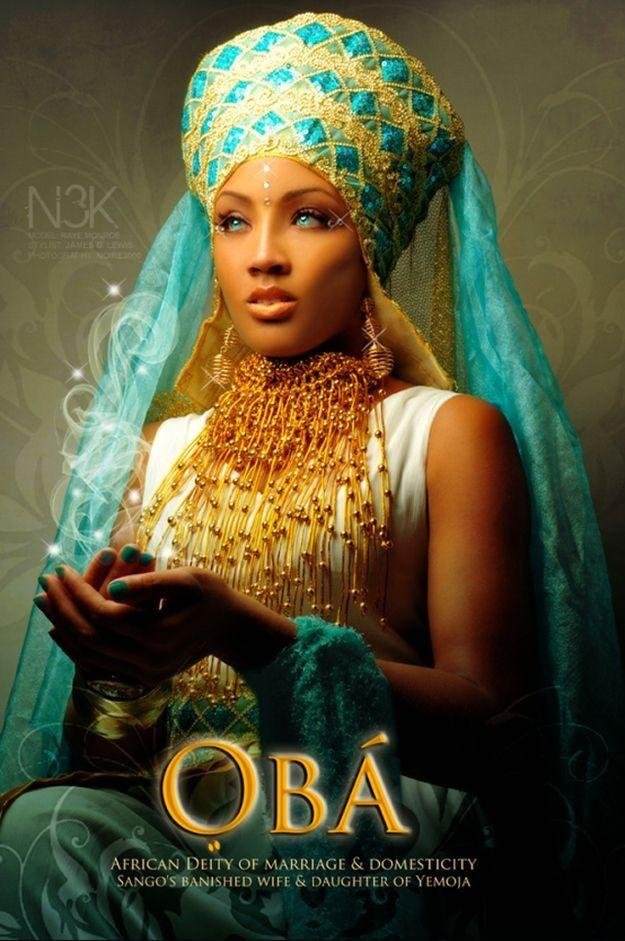
Ọba [Obba], is the Nigerian and Santarian Goddess of the River, Daughter of Yemaja[Mother Goddess] ; She was Married to Sango [God of Thunder].
The thing is both her sisters were also married to Sango – Oya and Oshun. So a little bit of rivalry existed between the three of them.
According to Legend, Oba was the first wife and her children were set to be the heir to Sango’s kingdom. Sango however loved Oshun more than the rest of his wives because she was the best cook out of them all.
Oba on the other hand, desperate to please Sango once asked Oshun how she succeeded in making Sango so happy all the time. Oshun was not pleased with the idea of sharing her secret with Oba, afterall Oba was the first wife and only her children stood to gain anything from Sango’s kingdom.
Initially she point blank refused to tell Oba anything but after much begging and pleading, Oshun had an idea; She told Oba that the reason why Sango loved her so much was because she cut a piece of her ear, and added it to Sango’s food as part of the ingredients.
Oba was visibly pleased, she decided to out do Oshun by cutting her whole ear off instead of “a little piece”. The very next day she cut one ear off and put it in a well garnished food she had prepared, she was all smiles as she presented it to Sango encouraging him to eat as much as he could.
Not long after Sango started eating did he notice the piece of Ear floating in the Soup; His face burned with rage as he threw the pot of soup on the floor, he accused Oba of trying to poison him and he banished her from the house. She cried so much, her heavy sobs began to turn into a river and the more she cried, the more she a pool of water began to form around her until she eventually turned into the River Oba which intersects with the Oṣun river at turbulent rapids, to show the rivalry between the two wives. She is still worshipped there today.
Source
Follow me on Facebook for UpDates!!
--
If this blog post has entertained you in any way, please follow, upvote, resteem and/or consider buying me a coke:
BTC Wallet -
1EyHQrBUGSwhGPjWZHjkFZe11tNMEiAKZW
ETH Wallet -
0xcBbd3270a8c7FA7a3aCc2F01cFa1EBb4831df7B5
Steemit Wallet - @awolesigideon

##########
Source for all the images was from buzzfeed
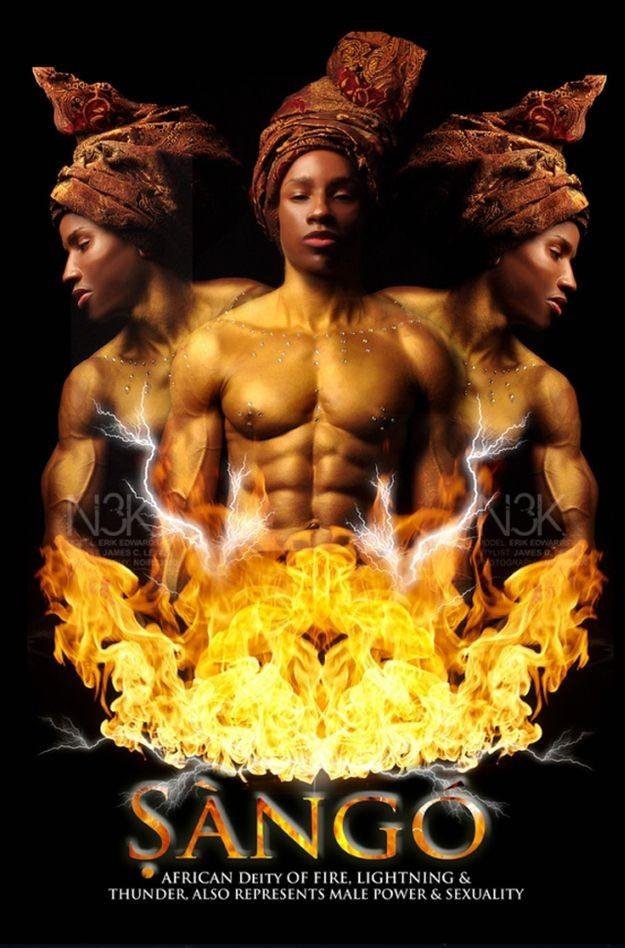
Bros I recommend you for as many votes as possible
Thank ypuuuu😆😆😆 ...hoped you Resteemed it sha
Hello brother. This was really entertaining but do share the source of your images so that your dont seem like plagiarism
Thank you for the tip. I've added it. Thanks for reading.
Good research bruv
I still wonder why they had History removed from the Nigerian curriculum. We need to know and appreciate our past.
Keep it up
Wow this is lovely
Have been looking for an anthropologist here on steemit who will write concerning Nigeria
This was great, did you write all this in case not try to put the reference.
Staying tuned for more of your posts
Wow.
This is enlightening.
I never know this much about African culture.
Thanks for the write up.
OMG OMG. what a knowledge filled post
Nice
Great work
Wow this is such a great post. I have never really seen anything like it. Thanks for sharing. I'm going to resteem.